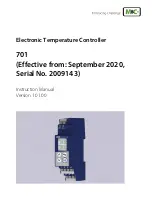
N1030 Controller
NOVUS AUTOMATION
2/5
dif
Differential alarm. In this function, SPA1 represents
an error (difference) between CONTROL PV and SP.
SP
PV
SP + SPA1
SP – SPA1
SP
PV
SP – SPA1
SP + SPA1
Positive SPA1
Negative SPA1
difl
Alarm of minimum differential value. It triggers when
the PV value is
below
the defined point by SP-SPA1.
SP
PV
SP – SPA1
SP
PV
SP – SPA1
Positive SPA1
Negative SPA1
difk
Alarm of maximum differential. It triggers when the PV
value is
above
the defined point by SP+SPA1.
SP
PV
SP + SPA1
SP
PV
SP + SPA1
Positive SPA1
Negative SPA1
ierr
Open sensor alarm. It triggers when the input
presents problems such as a broken sensor, poorly
connected sensor etc.
Table 2 –
Alarm functions
Important note
: Alarms configured with the
ki
,
dif
, and
difk
functions also trigger their associated output when a sensor fault is
identified and signaled by the controller. A relay output, for example,
configured to function as a Higher Alarm (
ki
), will operate when the
SPA1 value is exceeded and when the sensor connected to the
controller input is broken.
ALARM INITIAL BLOCKING
The
Initial Blocking
option inhibits the alarm from being triggered if
an alarm condition exists when the controller is turned on. The alarm
is triggered only after the process goes through a non-alarm
condition.
The initial blocking is useful, for example, when one of the alarms is
configured as a minimum value alarm, which can cause the alarm to
be triggered as soon as the process is started (a behavior that is
often undesired).
The initial block is not valid for the
ierr
function.
OFFSET
Function that allows you to make a small adjustment to the PV
indication. Allows you to correct measurement errors that appear, for
example, when replacing the temperature sensor.
OPERATION
The front panel of the controller can be seen in the figure below:
Figure 2 –
Front panel identification
Display
: Displays the measured variable, configuration parameter
symbols and their respective values/conditions.
TUNE Indicator
: Stays on while the controller is in tuning process.
OUT Indicator
: Signals the control output(s) status.
A1 and A2 Indicators
: Signal the occurrence of an alarm condition.
P
Key
: Key used to advance the successive parameters and
parameter cycles.
Increment key and
Decrement key
: Keys used to change
parameter values.
Back key
: Key used to move back parameters during
configuration.
OPERATION
When turned on, the controller shows the software version for the
first 3 seconds, then it shows the value of the measured process
variable (PV) in the upper display. In the lower display, it shows the
SP value. This is the
Indication Screen
.
To be used in a process, the controller must be previously
configured. To configure it, each of the various parameters presented
must be defined. You must understand the importance of each
parameter and determine a valid condition or value.
The configuration parameters are gathered in affinity groups, called
parameter cycles. The 3 parameter cycles are:
1 – Tuning / 2 – Input / 3 – Calibration
The
P
key gives access to the cycles and their parameters.
By keeping the
P
key pressed, every 2 seconds the controller
jumps from one cycle to another, presenting the first parameter of
each cycle:
PV
>>
atvn
>>
type
>>
PASS
>>
PV
…
To enter the desired cycle, simply release the
P
key when the first
parameter is displayed. To move forward through the parameters of
that cycle, use the
P
key. To go backwards through the
parameters, use the
key.
The symbol of each parameter is shown in the upper display. Its
respective value/condition is shown in the lower display.
Depending on the configuration protection that you have adopted, the
PASS
parameter is shown as the first parameter of the cycle where
the protection starts. See
Configuration Protection
chapter.
PARAMETERS DESCRIPTION
INDICATION SCREEN
PV
SP
Temperature indication screen
. The upper (red)
display shows the value of the measured variable (
PV
)
temperature.
The lower display (green) shows the control setpoint
value (
SP
), which is the desired value for the process
temperature.
Spa1
Alarm SP. Value that defines the alarm actuation point.
For
Differential
type functions, this parameter
specifies error (*).
TUNING CYCLE
Atvn
AUTO-TUNE
. Enables the automatic tuning of the
PID parameters (
pb
,
ir
,
dt
). See
PID Parameters
Definition
chapter.
off
Auto-tune off.
Fast
Perform tuning in fast mode.
Full
Perform tuning in precise mode.
PB
Proportional Band. Value of the term
P
of the control
mode PID, in percentage of the maximum span of the
input type.
Adjustable between 0 and 500.0 %.
When set to zero (0), control action is ON/OFF.
ir
Integral Rate. Value of the term
I
of the PID algorithm,
in repetitions per minute (Reset).
Adjustable between 0 and 24.00.
Displayed only if proportional band
≠
0.























